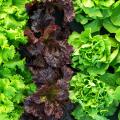Mustard Greens
Mustard Greens

Mustard greens are quick and easy to grow in spring and fall. Mustard does not tolerate heat and bolts (runs to seed) when weather warms in late spring.
Plant seeds 4 to 6 weeks before the last frost in spring and 6 to 8 weeks before the first frost in fall. Several plantings, a couple of weeks apart, provide a continuous supply of mustard. Harvest by cutting entire plants, breaking off only the large leaves, or cutting plants to within an inch or so of the crowns, permitting regrowth for a second harvest. Curly leaved varieties trap a lot of sand that is difficult to wash off.
Varieties
- Florida Broad Leaf—broad, flat leaf; sawtooth edge; the most popular garden variety.
- Green Wave—very curly leaf; AAS 1957.
- Southern Giant Curled—very curly leaf.
- Tendergreen (Mustard Spinach)—strap-shaped leaf; smooth.
- Garnet Giant—attractive red leaves that turn green when cooked.
Publications
News
If you grow your own vegetables, you will likely see at least a few pesky insects that want to feed on your plants. Slugs are one of the pests you may be noticing now.
Did you know yellow squash is in the pumpkin family and are 95 percent water?
Tomatoes are a popular crop, both for commercial growers and home gardeners. Even the best tomato growers run into problems along the way! We put together a simple, easy-to-follow guide to help you spot a few of the most common tomato troubles gardeners see.




